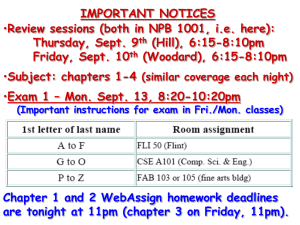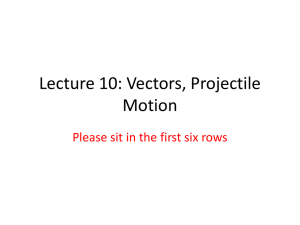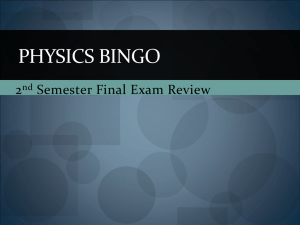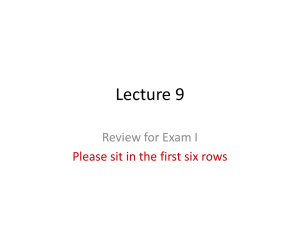phy ch 3 - wbm
advertisement
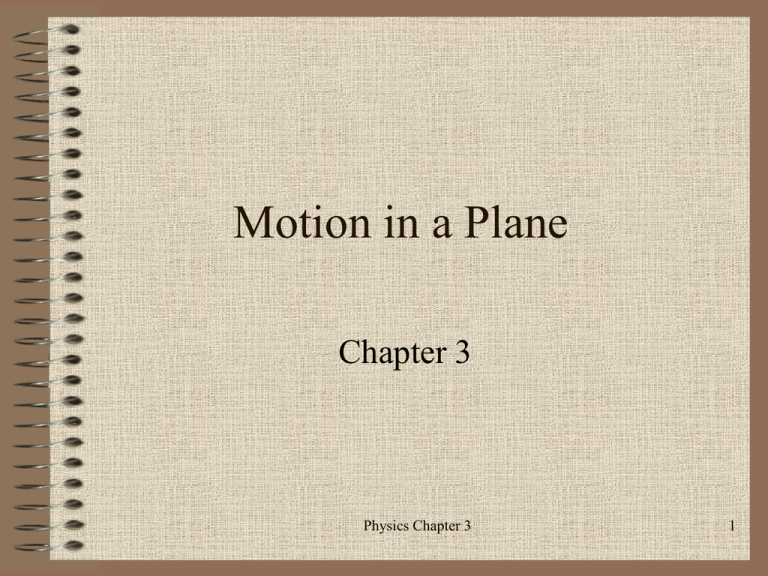
Motion in a Plane Chapter 3 Physics Chapter 3 1 Position Vector • Goes from the origin to the object – point p y P r Physics Chapter 3 x 2 Average Velocity Vector • Change in displacement over change in time v av r t Physics Chapter 3 3 Instantaneous velocity vector v lim t 0 r t Physics Chapter 3 4 Instantaneous velocity • In two dimensions v v 2 vx vy tan 2 vy vx Physics Chapter 3 5 Average acceleration vector a av v t Physics Chapter 3 6 Instantaneous acceleration vector a lim t 0 v t Physics Chapter 3 7 Example • A particle has x and y coordinates (4.0 m, 2.0 m) at time t1 = 2.0 s and coordinates (7.0 m, 6.0 m) at time t2 = 2.5 s. Find the components of the average velocity and the magnitude and direction of the average velocity during this time interval. Physics Chapter 3 8 Projectile Motion • Projectile – any body given an initial velocity which then follows a path (trajectory) based on gravitational acceleration and air resistance • Thrown ball • Bullet • Dropped package Physics Chapter 3 9 Projectile motion • We will neglect air resistance • We will also neglect curvature and rotation of the earth Physics Chapter 3 10 Projectile Motion • Consists of both horizontal and vertical motion • We will break these problems into x and y components to make them easier to solve Physics Chapter 3 11 Projectile motion • Two dimensional – gravity only acts vertically • We assign y as the vertical direction • We assign x as the horizontal direction ax 0 ay g Physics Chapter 3 12 Projectile Motion 0 v x v0 x a x t v x v0 x v y v 0 y gt x x0 v0 xt 1 2 0 a xt 2 x x0 v xt y y0 v0 yt Physics Chapter 3 1 gt 2 2 13 Projectile Motion • If we express initial velocity in terms of its magnitude and angle with the x-axis v 0 x v 0 cos 0 v 0 y v 0 sin 0 Physics Chapter 3 14 Projectile Motion • We can calculate the projectile’s speed and the direction of its velocity v 2 vx vy tan 2 vy vx Physics Chapter 3 15 Trajectory shape • Projectiles always travel in parabolas Physics Chapter 3 16 Example • A policeman chases a thief across city rooftops. They are both running at 5 m/s when they come to a gap between buildings that is 4 m wide and has a drop of 3 m. • The thief leaps at 5 m/s at an angle of 45°. Does he clear the gap? • The policeman leaps at 5 m/s horizontally. Does he clear the gap? Physics Chapter 3 17 Example x0 y0 Physics Chapter 3 18 Example – the thief x x0 v xt x0 0 x v xt v0 5 m s @ 45 m vx 5 cos 45 s m x 5 cos 45 t Chapter 3 sPhysics 19 Example – the thief y0 0 v0 5 m @ 45 v0 y s 0 y y0 v0 yt y v0 y t 1 1 m 5 sin 45 s gt 2 2 gt 2 2 Physics Chapter 3 20 Example – the thief 1 2 gt v 0 y t y 0 2 when he hits the roof, y 3 m m 2 m 4 .9 2 t 5 sin 45 t 3 m 0 s s Physics Chapter 3 21 Quadratic formula ax bx c 0 2 x b b 4 ac 2 2a Physics Chapter 3 22 Example – the thief m 2 m 4 .9 2 t 5 sin 45 t 3 m 0 s s t m 5 sin 45 s 2 m m 3 m 5 sin 45 4 4 . 9 2 s s m 2 4 .9 2 s Physics Chapter 3 23 Example – the thief t m 3.54 s 2 2 m m 12 . 5 2 58 . 8 2 s s m 9 .8 2 s m m 3.54 8.44 s s t m 9 .8 2 s Physics Chapter 3 24 Example – the thief 11 . 98 t m 4 .9 m s or t s m m 9 .8 2 9 .8 2 s s t 1 . 22 s Physics Chapter 3 25 Example – the thief m x 5 cos 45 t s m x 5 cos 45 1 . 22 s s x 4 . 32 m • Yes, he clears the gap Physics Chapter 3 26 Example – the policeman • Everything is the same, except that v0 5 m @0 s m vx 5 s v0 y 0 Physics Chapter 3 27 Example – the policeman m x 5 t s y 1 gt 2 2 y t 2 1 g 2 Physics Chapter 3 28 Example – the policeman when he hits the roof, y 3 m t 2 3m m 4 .9 2 s t 0 . 61 s 2 2 t 0 . 78 s Physics Chapter 3 29 Example – the policeman m x 5 t s m x 5 0 . 78 s s x 3 .9 m • No, he does not clear the gap Physics Chapter 3 30 Example 2 • A rookie quarterback throws a football with an initial upward velocity component of 16.0 m/s and a horizontal component of 20.0 m/s. a) How much time is required for the football to reach the highest point of the trajectory? Physics Chapter 3 31 Example 2 a) • At the highest point, vy must be zero. • Before that, it was moving up, and after that it is moving down, so it must momentarily stop at that point. v y v 0 y gt vy 0 v 0 y 16 . 0 Physics Chapter 3 m s 32 Example 2 a) m 0 16 . 0 9 .8 2 t s s m 16 . 0 t m s m 9 .8 2 s t 1 .6 s Physics Chapter 3 33 Example 2 b) • b)How high is this point? y y0 v0 yt y0 0 1 gt 2 2 v 0 y 16 . 0 m s t 1 .6 s Physics Chapter 3 34 Example 2 b) m 1 m 2 y 16 1 . 6 s 9 . 8 2 1 . 6 s s 2 s y 25 . 6 m 12 . 5 m y 13.1 m Physics Chapter 3 35 Example 2 c) • c) How much time is required for the ball to return to its original height? y y0 v0 yt 1 gt 2 2 y0 y0 0 v 0 y 16 . 0 m s Physics Chapter 3 36 Example 2 c) 0 v0 y t 1 2 1 gt 2 2 gt v 0 y t 0 2 1 t gt v 0 y 0 2 Physics Chapter 3 37 Example 2 c) 1 or gt v 0 y 0 2 t 0 1 2 gt v 0 y t 2v0 y g Physics Chapter 3 38 Example 2 c) m 2 16 s t m 9 .8 2 s t 3 .2 s Physics Chapter 3 39 Example 2 d) • d) How does the answer to part c) compare to the answer to part a)? • It is double. When something is thrown upward, it always takes the same amount of time to go up as it does to come down. So the total flight time (back to the original height) is always twice the time to the highest point. • Physics Chapter 3 40 Example 2 e) • e) How far has the football traveled horizontally? x x0 v xt x0 0 v x 20 m s t 3 .2 s Physics Chapter 3 41 Example 2 e) m x 20 3 . 2 s s x 64 m Physics Chapter 3 42 Normal acceleration • Normal means perpendicular • The component of acceleration that is perpendicular to the path • Shows change in direction of velocity a or a norm Physics Chapter 3 43 Tangential acceleration • Parallel to the path • Shows change in magnitude of velocity (change in speed) a or a tan Physics Chapter 3 44 Uniform Circular Motion • When an object moves around a circle with constant speed, the acceleration vector points towards the center of the circle. • The velocity is tangent to the circle. In order for the speed to remain constant, the acceleration must be towards the center of the circle. • We call this centripetal acceleration. Physics Chapter 3 45 Uniform circular motion • See Fig. 3-11 on page 63 v v1 a av s v R v t v1 s R v1 s a Rt v R a v lim t0 s t 2 R Physics Chapter 3 46 Uniform circular motion • The period of any motion is the time it takes to make one complete cycle. It is denoted with the letter T. • In this case it’s the time to go around the circle once. v av d v t 2 R T 4 R 2 a T 2 Physics Chapter 3 47 Example • The radius of the earth’s orbit around the sun is 1.49 x 1011 m, and the earth travels around the sun in 365.25 days. • What is the earth’s orbital speed in m/s? • What is the acceleration of the earth toward the sun in m/s2? Physics Chapter 3 48
